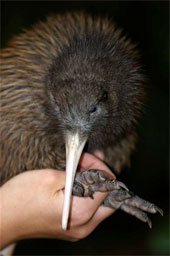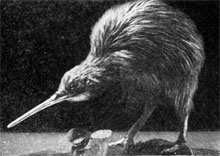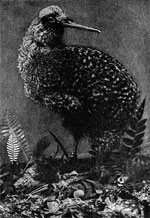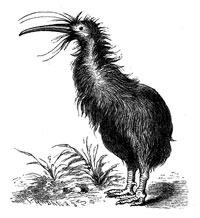
 Honorary Mammal: Prior to the arrival of humans in the 13th century or earlier, New Zealand's only endemic mammals were three species of bat, and the ecological niches that in other parts of the world were filled by creatures as diverse as horses, wolves and mice were taken up by birds (and, to a lesser extent, reptiles). Honorary Mammal: Prior to the arrival of humans in the 13th century or earlier, New Zealand's only endemic mammals were three species of bat, and the ecological niches that in other parts of the world were filled by creatures as diverse as horses, wolves and mice were taken up by birds (and, to a lesser extent, reptiles).
Swiss Army Beak: Kiwi are shy nocturnal creatures with a highly developed sense of smell and, most unusual in a bird, nostrils at the end
of their long bill. They feed by thrusting the bill into the ground in search of worms, insects, and
other invertebrates; they also take fruit and, if the opportunity arises, small crayfish, amphibians
and eels.
Flightless and Loving it: Their adaptation to a terrestrial life is extensive: like all ratites they have no keel on the breastbone to anchor wing muscles, and barely any wings either: the vestiges are so small that they are invisible under the kiwi's bristly, hair-like, two-branched feathers. While birds generally have hollow bones to save weight and make flight practicable, kiwi have marrow, in the style of mammals. With no constraints on weight from flight requirements, some Brown Kiwi females carry and lay a single 450 g egg.
 Family Ties: It was long presumed that the kiwi's closest relatives were the other New Zealand ratites, the moa. However recent DNA studies indicate that the Ostrich is more closely related to the moa and the kiwi's closest relatives are the Emu and the cassowaries. This theory suggests that the kiwi's ancestors arrived in New Zealand from elsewhere in Australasia well after the moa. Family Ties: It was long presumed that the kiwi's closest relatives were the other New Zealand ratites, the moa. However recent DNA studies indicate that the Ostrich is more closely related to the moa and the kiwi's closest relatives are the Emu and the cassowaries. This theory suggests that the kiwi's ancestors arrived in New Zealand from elsewhere in Australasia well after the moa.
According to British scientists, the kiwi may be an ancient import from Australia. Researchers of Oxford University have found DNA evidence connected to Australia's Emu and the Ostrich of Africa. Upon examining DNA from New Zealand's native moa, they believe that the kiwi is more closely related to its Australian cousins.

Kiwi Couples: After an initial meeting during mating season (June to March), kiwi usually live as monogamous couples. The pair will meet in the nesting burrow every few days and call to each other at night. These relationships have been known to last for up to 20 years.
Impressive Eggs: Kiwi eggs can weigh up to one quarter the size of the female. Usually only one egg is laid. Although the Kiwi is about the size of a domestic chicken, it is able to lay eggs that are up to ten times
larger than a chicken's egg.

Currently there are three accepted species, one of which has two sub-species:
 The largest species is the Great Spotted Kiwi, Apteryx haastii, which stands about 450 mm high and weighs about 3.3 kg. (Males about 2.4 kg) It has The largest species is the Great Spotted Kiwi, Apteryx haastii, which stands about 450 mm high and weighs about 3.3 kg. (Males about 2.4 kg) It has
grey-brown plumage with lighter bands. The female lays just one egg, with both sexes incubating. Population
is estimated to be over 20,000, distributed through the more mountainous parts of northwest Nelson,
the northern West Coast, and the Southern Alps.
The very small Little Spotted Kiwi, Apteryx owenii is unable to survive predation by imported pigs, stoats and cats and is extinct on the mainland and the most threatened of all kiwi. About 1350 remain on Kapiti Island and it has been introduced to other predator-free islands and appears to be becoming established with about 50 'Little Spots' on each island. A docile bird the size of a bantam, it stands 250 mm high and the female weighs 1.3 kg. She lays one egg which is incubated by the male.
The Brown Kiwi, Apteryx mantelli is widespread in the northern two-thirds of the North Island and with about 35,000 remaining is the most common kiwi. Females stand about 400 mm high and weigh about 2.8 kg, the males about 2.2 kg. The North Island Brown has demonstrated a remarkable resilience: it adapts to a wide range of habitats, even non-native forests and some farmland. The plumage is streaky red-brown and spiky. The female usually lays two eggs, which are incubated by the male.
The Okarito Brown Kiwi or Rowi, Apteryx rowi, is a recently identified species, slightly smaller, with a greyish tinge to the plumage and sometimes white facial feathers. Females lay as many as three eggs in a season, each one in a different nest. Male and female both incubate. These Kiwi are distributed in the South Island of New Zealand.
 The Southern Tokoeka, Apteryx australis australis, relatively common species of kiwi known from southwest South Island (Fiordland) that occurs at most elevations. It is approximately the size of the Great Spotted Kiwi and is similar in appearance to the Brown Kiwi but its plumage is lighter in colour. The Southern Tokoeka, Apteryx australis australis, relatively common species of kiwi known from southwest South Island (Fiordland) that occurs at most elevations. It is approximately the size of the Great Spotted Kiwi and is similar in appearance to the Brown Kiwi but its plumage is lighter in colour.
The Stewart Island Tokoeka, Apteryx australis lawryi, is a subspecies of Southern Tokoeka known from Stewart Island.
The Haast Tokoeka, Apteryx n. sp. (?fusca), is the rarest species of kiwi with only about 300 individuals. It was identified as a distinct form in 1993. It only occurs in a restricted area in South Island's Haast Range at an altitude of 1,500 m. This form is distinguished by a more strongly downcurved bill and more rufous plumage.
All text is available under the terms
of the GNU Free Documentation License
|